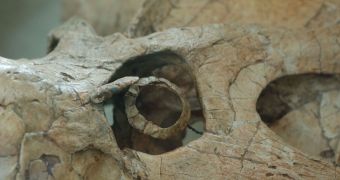According to the conclusions of a new scientific study, it would appear that the blockbuster movie Jurassic Park was right on one thing, and namely the fact that some dinosaurs indeed hunted at night.
This was determined after experts analyzed the eyes and eye sockets of several extinct species of ancient animals. Most notably, Velociraptors were discovered to be nocturnal, which means that they came out very little during the day.
On the other hand, the most massive, herbivore dinosaurs came out around the clock. This makes sense, considering that their massive size required them to feed at all times. Their metabolism most likely needed to be fueled non-stop.
Details of the new research were published in this week's online issue of the esteemed journal Science Express. The new data are in direct conflict with the conclusions of past studies, which showed that dinosaurs mostly roamed the land by day.
Until now, it was believed that only mammals scoured the landscape during the night. However, University of California in Davis (UCD) geologist Ryosuke Motani says that this was not the case.
“It was a surprise, but it makes sense,” the expert says of the new finding. Motani is also a coauthor of the new Science Express paper. He conducted the work with postdoctoral researcher Lars Schmitz.
“These authors' conclusion that these dinosaurs were active diurnally and nocturnally challenges a general dogma – that nocturnality in that time was mostly restricted to mammals,” explains scientist H. Richard Lane.
He holds an appointment as a program director in the US National Science Foundation (NSF) Division of Earth Sciences (DES), the organization that provided the funds needed to conduct this research.
Interestingly, the new work suggests that the ecology of the habitats in which various types of dinosaurs lived influenced their behavior to a great extent. This is the only way to explain why some of the giant lizards lived predominantly at night, whereas others only came out during the day.
Big plant-eating dinosaurs were the most active of the bunch, the team says. They only hid for several hours per day, during the afternoon, when the Sun was out and temperatures reached very high levels.
Like a number of other small carnivores, Velociraptors were nigh predators, as indicated by their large eyes. When it came to determining whether Tyrannosaurus Rex was also nocturnal, experts hit a block, because insufficient fossils are available for a clear conclusion to be drawn.

 14 DAY TRIAL //
14 DAY TRIAL //